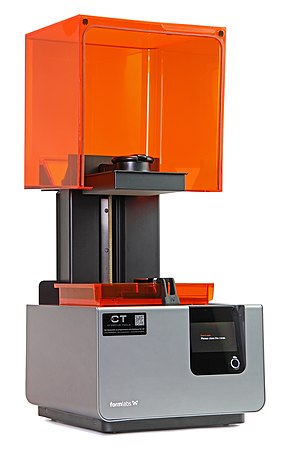3D Printing/Printer Types
Fused Filament Fabrication (FFF)
[edit | edit source]FFF printers operate by melting material from an extruder to produce a 3D object.
FFF printers are known for being easier to use than other printing technologies, partly due to requiring less safety equipment for operation.[1] Cartesian FFF 3D printers work by moving an extruder along an X, Y, and Z, axis.[2]
On Stratasys 3D printers the name FDM is used for the same technique.
-
A Prusa i3, a common cartesian FFF 3D printer. Cartesian 3D printers have a cuboid build area.
-
A Fisher Delta RepRap 3D Printer. The build area on a delta printer is a cylinder with a conic top.
Stereolithography (SLA)
[edit | edit source]SLA printers use light to solidify a special liquid.[3][4]
Unlike an FFF printer, SLA printers build time is based on height and not the number of prints or object complexity, so the entire x and y build area can be used for prints with no impact on printing time.[5] Unlike FFF printers, SLA printers typically print upside down,[5] though this has little tangible effect on the final print. SLA printers can be difficult to operate.[6]
-
A Formlabs Form2 SLA 3D Printer.
-
Form 2 curing equipment. SLA prints require curing following the print process.
Selective laser sintering (SLS)
[edit | edit source]SLS works by fuzing powders together with a laser to create 3D objects.
Uniquely, SLS printers requires no dedicated support structures for complex geometries.[1]
-
An SLS 3D Printer.
References
[edit | edit source]- ↑ a b "3D Pinter Buyers Guide FFF vs SLA vs SLS". LulzBot. 30 August 2019. Retrieved 30 November 2020.
- ↑ "3D Printer Assembly Mentor2". Retrieved 29 November 2020.
- ↑ "The Ultimate Guide to Stereolithography (SLA) 3D Printing (Updated for 2020)". Formlabs. Retrieved 29 November 2020.
- ↑ "3D Printing: A Multitude of Machines & Materials-SLA/DLP Printing – Techbytes". Retrieved 29 November 2020.
- ↑ a b "How to slice 3D objects for the Original Prusa SL1 [updated with video guide]". Prusa Printers. 19 June 2019. Retrieved 29 November 2020.
- ↑ Finnes, Tyler (1 January 2015). "High Definition 3D Printing – Comparing SLA and FDM Printing Technologies". The Journal of Undergraduate Research. Retrieved 29 November 2020.




